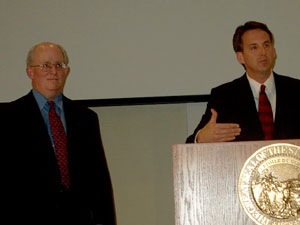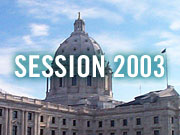|
Audio
Photos
Your Voice
|
Spending on health targeted in Pawlenty budget
February 18, 2003
 |
| In announcing his budget plan, Gov. Pawlenty called the state's rising health care costs "the sumo wrestler in the room that needs to be tackled to the ground." Finance commissioner Dan McElroy is at left. (MPR Photo/Tom Scheck) |
St. Paul, Minn. — In announcing his budget plan, Gov. Pawlenty called the state's rising health care costs "the sumo wrestler in the room that needs to be tackled to the ground." He says government is one of the largest consumers of health care.
Pawlenty says he wants to limit the rise in costs. He's proposing an 8 percent increase to health and human services programs. The programs, however, were scheduled to grow 20 percent over the next biennium. Pawlenty says it's time to start making changes in how the state delivers health care to its citizens.
"It is consuming us at a rate and scope that we cannot sustain," Pawlenty says. "So changes need to be made. And in the near term, Commissioner Goodno and others led efforts to get the increase to 8 percent and begin the process of making programatic changes. And many of these changes are difficult. There's no question about it."
Pawlenty's budget proposal would eliminate General Assistance Medical Care, a state-sponsored program that provides health insurance to 30,000 low-income adults who don't have children. He says he wants to roll those particiants into MinnesotaCare, the state-subsidized health insurance program. The governor is also proposing stricter eligibility requirements for MinnesotaCare and medical assistance.
|
At first glance, it appears the Governor has gone through
government agencies and programs with a fine tooth comb. We offered
proposals to down-size bureaucracy, cut duplication of services,
trim costs, and eliminate programs that are not an appropriate role
of the government. We're pleased to see some of our proposals
included in his recommendations.
- Twila Brase, president of the Citizens Council on Health Care |
Minh Ta, with the Children's Defense Fund, says the changes would cut a lot of people from MinnesotaCare. For example, under the current rules, lower income people are eligible if they have no health insurance, or if their employer offers to pay less than half of their insurance. Ta says Pawlenty's proposal would elminate eligibility if an employer offers any type of health insurance.
"The devil is in the details, and there are major changes to basic support programs to Minnesota families and kids," says Ta. "They're either gutted or eliminated or drastically reduced."
Ta also says Pawlenty's proposal to group a number of health and human service grants into larger block grants will provide less money for child abuse prevention, child care and nutrition programs.
Other groups are criticizing Pawlenty for using the state's $1 billion in tobacco endowments to balance the budget. The endowments are used to pay for medical education, the University of Minnesota's Academic Health Center and anti-smoking programs.
Pawlenty has proposed other ways of funding the health center and medical education. Jeremy Hanson with the SmokeFree Coalition says he's upset Pawlenty is scrapping the state's anti-tobacco programs.
"Tobacco continues to be the number one cause of death in this state, and is one of the most important drivers to the cost of health care. This is a short-term solution, but is going to create a lot of problems down the road. As more kids start smoking, more of them are going to get sick and die from tobacco, and we're all going to pay the consequences," says Hanson.
House Republicans support Pawlenty's proposed changes to health and human services. Rep. Jim Knoblach, R-St. Cloud, says the state needs to get a better handle on rising health care costs. Knoblach, who chairs the House Ways and Means Committee, says the state needs to roll back some of the programs if it wants to stay in good fiscal health.
"Broadly speaking, we aren't going to be looking at raising taxes in the House. Broadly speaking, we're going to have to be looking at some major reductions in the rate of growth in health and human services," says Knoblach. "We're the number two spending state in the country per capita in health and human services. We just can't remain that far out of the loop."
Pawlenty also noted that Minnesota serves more people and pays for a broader range of health care services than most states, covers people at higher income levels than most states, and is one of only a handful of states to cover all optional services.
Even with the reductions he proposes, Pawlenty says Minnesota will continue to provide health care benefits for its most vulnerable populations that exceed the national average. He noted that 15 states passed health benefits reductions for 2003, and 18 states are planning health care eligibility cuts this year.
DFLers in the Senate say they aren't prepared to comment on Pawlenty's proposed changes until they have a chance to better examine them. The Health, Human Services and Corrections Budget Division will hold hearings on the budget proposal throughout the week.
|
News Headlines
|
Related Subjects
|

